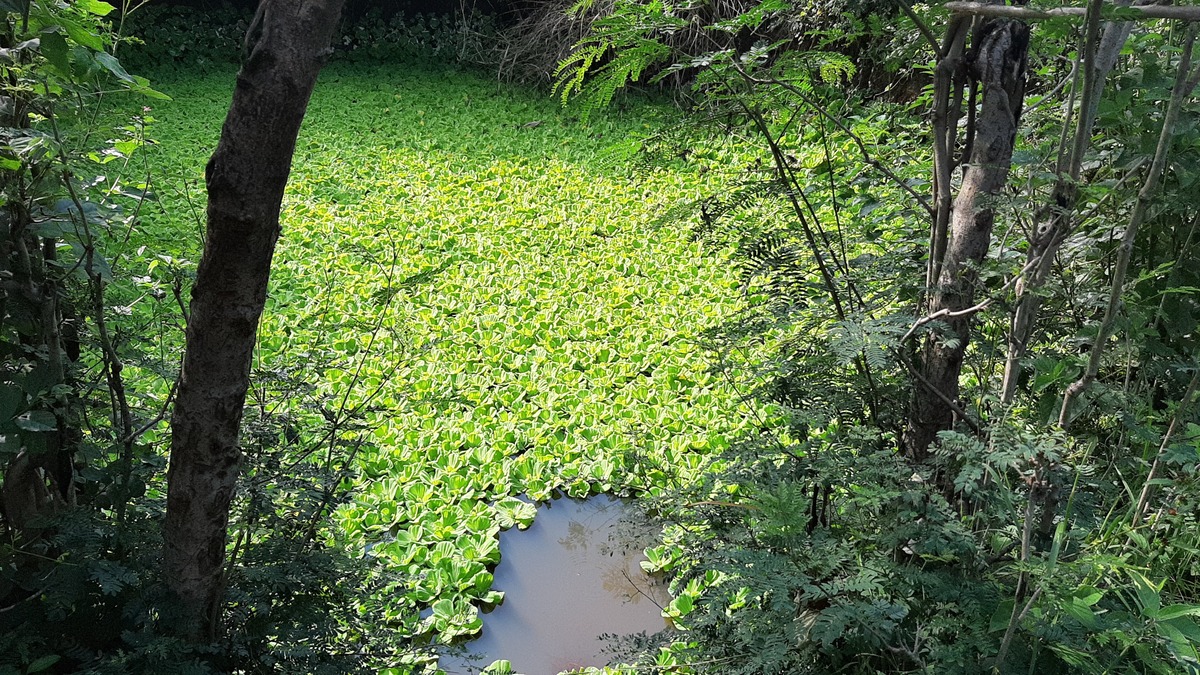Meet the Kenyan small-scale farmers fighting climate change through agroecology
Ten years ago, 59-year-old Eunice Outa would have expected a harvest of no more than 30 kilograms of Maize, sorghum or whatever crop she had decided to plant for the season from her 2.5-acre farm in Nyakack area of Kenya’s Kisumu county.
Unstable weather patterns in the area over the past 20 years have caused an erratic crop yield.
To overcome this challenge, Outa decided to shift from her largely fertilizer-based farming technique to agroecology, an agricultural practice that not only focuses on food production but also on the sustainability of the ecosystem.

A pond of the harvested water covered in water lettuce that helps irrigate Eunice's farm during the dry season. Janet Murikira.
As part of the practice, Outa includes several farming techniques like intercropping, crop rotation, the use of plant manure, rainwater harvesting and agroforestry.
“As soon as I harvest the sorghum and cow peas I will plant something else next season. I could opt for tomatoes or spring onions, ” Outa says.
Another farmer, 45-year-old Eddy Ouko, started practicing agroecology in 2005 after realizing that his land had been largely degraded.
According to the recently released IPCC special report on climate change, desertification, land degradation, sustainable land management, food security, and greenhouse gas fluxes in terrestrial ecosystems, land is both a source and sink for greenhouse emissions.
“When land is degraded, it becomes less productive, restricting what can be grown and reducing the soil’s ability to absorb carbon. This exacerbates climate change, while climate change in turn exacerbates land degradation in many different ways,” the report said.
Agriculture is an important economic activity in Kenya, contributing 26% to the Gross Domestic Product.
Despite the Kenyan agricultural sector being the eighth largest in Africa by volume, it is threatened by the effects of climate change. Droughts and floods had left 3.4 million Kenyans food insecure and 309,000 internally displaced as of 2018.
The World Bank indicates that the impact of climate change is more severe across the African continent. More than 60% of households having reported shocks as a result of inflating food prices that are caused by unpredictable weather patterns.
In croplands, emissions of nitrous oxide, (N2O), a gas that is 310 times more destructive to the environment than carbon dioxide, is a major concern. Up to 90% of the fertilizer used in Kenya has a nitrate component.
Over-application of nitrate fertilizers lead to increased acidity in the soil.
Scientists argue that practices such as excessive tillage and fertilizer application cause soil degradation, thus hastening the release of carbon dioxide into the air.
As of 2013, Kenya’s greenhouse emissions stood at 60.2 million metric tons with agriculture contributing 62.8% of the emissions due to unsustainable land use.
The Kenya national climate action plan (2018-2021) seeks to make agriculture sustainable with several mitigation measures that include agroforestry, crop diversification, increased water harvesting and sustainable land management.
But for farmers like Outa who are among the economic groups that are most vulnerable to the effects of climate change in Kenya, change must not come from policymakers.


